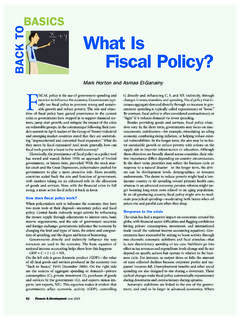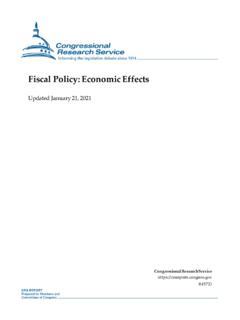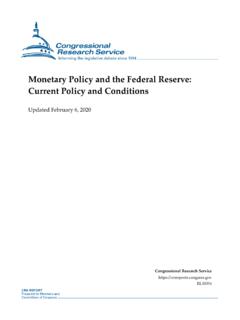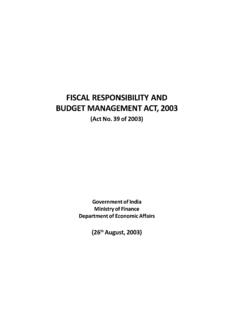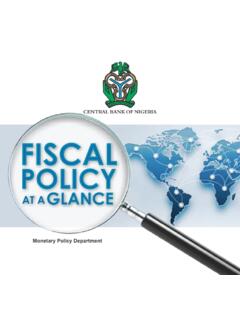Transcription of Monetary Policy for 2020/21 - NRB
1 Unofficial Translation Monetary Policy for 2020/21 . Nepal Rastra Bank Central Office Baluwatar, Kathmandu July 2020. Monetary Policy for 2020/21 . Delivered by Governor Mr. Maha Prasad Adhikari On 17 July 2020. Nepal Rastra Bank Central office Baluwatar, Kathmandu Nepal Rastra Bank Central office Baluwatar, Kathmandu Nepal Phone No: 4410158. Website: TABLE OF CONTENTS. Background .. 1. Global Economic Outlook .. 2. Macro Economic Situation .. 3. Financial Sector 4. Review of Monetary Policy 2019/20 .. 6. Monetary Management .. 6. Review of Financial Sector Program .. 7. Major Policy Provisions in the Context of COVID-19 .. 8. Economic Outlook for 2020/21 .
2 9. Monetary Policy Framework for 2020/21 .. 10. Monetary Policy Stance .. 10. Economic and Monetary Target .. 10. Operating Target and Instrument .. 11. Financial Sector Provisions for 2020/21 .. 11. Credit Provision .. 11. Special Programs for Economic Revival .. 14. Business Operation Credit for COVID-19 Affected Business .. 15. Moratorium, Loan Restructuring and Rescheduling .. 15. Financial Sector 16. Regulation and Supervision .. 17. 19. Payment System .. 20. Foreign Exchange Management .. 21. Corporate Governance, Financial Literacy and Consumer Protection .. 22. Annex 1 Projection of Monetary Survey List of Statistical Tables ACRONYMS. ADBL : Agricultural Development Bank Limited AML : Anti-money Laundering ATM : Automated Teller Machine BFI : Banks and Financial Institution BOP : Balance of Payments CBS : Central Bureau of Statistics CCB : Countercyclical Buffer CCD : Credit-to-Core Capital and Deposit CFT : Combating the Financing of Terrorism CIB : Credit Information Bureau CIT : Citizen Investment Trust CPI : Consumer Price Index CRR : Cash Reserve Ratio CSR : Corporate Social Responsibility DAA : Documents against Acceptance DAP : Documents against Payment EPF : Employee Provident Fund FDI : Foreign Direct Investment FSDS : Financial Sector Development Strategy GDP.
3 Gross Domestic Product GoN : Government of Nepal IMF : International Monetary Fund IRC : Interest Rate Corridor KYC : Know Your Customer :LC : Letter of Credit LOI : Letter of Intent LOLR : Lender of the Last Resort LTV : Loan to Value M2 : Broad Money MFI : Microfinance Financial Institution MSMEs : Micro, Small and Medium Enterprises NEPSE : Nepal Stock Exchange NFRS : Nepal Financial Reporting Standards NPL : Non-Performing Loan NRB : Nepal Rastra Bank NRN : Non Resident Nepali PF : Provident Fund PSDI : Payment System Development Indicator PSO : Payment System Operator PSP : Payment Service Provider QR : Quick Response RTGS : Real Time Gross Settlement SLF : Standing Liquidity Facility SLR : Statutory Liquidity Ratio SPV : Special Purpose Vehicle y-o-y : year on year Monetary Policy for 2020/21 .
4 Background 1. The Monetary Policy for 2020/21 has been formulated at a time when the whole world is undergoing humanitarian as well as economic crises stemmed from the COVID-19. More than five hundred ninety three thousand people have lost their lives and more than fourteen million people have been infected due to an unanticipated pandemic occurred after a century. The global economy has experienced the biggest contraction after the Great Depression of 1930s. The health as well as economic crises emanated from the COVID-19 may give rise to poverty, unemployment and income inequality. 2. The COVID-19 has created an unprecedented challenge in the goal of attaining higher sustainable growth and maintaining social justice in order to realize the national aspiration of "Prosperous Nepal, Happy Nepali".
5 Unlike the robust economic growth attained in the past three years, lower growth is estimated for 2019/20. Though the growth remained subdued and credit expansion slowed, moderate inflation, decline in current account deficit, surplus balance of payments and higher deposit growth support the macroeconomic fundamentals. 3. Access to financial services has increased remarkably in the last few years. The use of digital means of payments is increasing along with the financial expansion. Further, the process of developing payments system infrastructure is moving forward. The increased use of mobile banking eased the settlement of banking transactions even during the period of lockdown.
6 4. Labor market and remittance flows have been affected worldwide owing to the COVID-19. The domestic labor market has witnessed an upsurge in labor supply with an increase in returnee migrants. Mobilizing deposit in the banking system, maintaining external sector balance and reducing poverty will be affected if remittance slows down owing to the economic contraction in the labor destination economies. 5. The Monetary Policy , in the presence of the challenges posed by the COVID-19, reinforces economic recovery while maintaining macroeconomic stability. Given this, the Policy is directed towards management of credit and enhancing further credit to COVID-hit areas.
7 Further, the credit should be channelized towards increasing 2 Nepal Rastra Bank production, generating employment and promoting entrepreneurship with a goal of fostering economic activities and reviving the economy. 6. Monetary Policy for 2020/21 has been formulated following the mandate of the Nepal Rastra Bank Act, 2002. The Policy is formulated taking into account the domestic as well as international economic outlook along with the Fifteenth Plan of the Government of Nepal (GoN), Government Budget for 2020/21 , Financial Sector Development Strategy (FSDS) and the Third Strategic Plan of Nepal Rastra Bank (NRB). Suggestions from various stakeholders have been duly considered while formulating the Policy .
8 Global Economic Outlook 7. World economy contracted on account of the production and supply chain disruptions that resulted from the measures adopted worldwide to contain the spread of COVID- 19. According to the World Economic Outlook updated by the International Monetary Fund (IMF) in June 2020, the world economy is projected to contract by percent in 2020. 8. The Advanced economies are projected to contract by percent in 2020 compared to an expansion of percent in 2019. The emerging and developing economies are projected to contract by 3 percent in 2020 compared to an expansion of percent in 2019. 9. The IMF has projected the Asian economies to contract by percent in 2020.
9 While the Indian economy is projected to contract by percent, the Chinese economy is projected to expand by 1 percent. The IMF projects the growth rate of Nepal to remain 1 percent in 2020. 10. Inflation has moderated with contraction in aggregate demand and falling oil price due to the effect of COVID-19. The IMF has projected inflation in the developed economies to remain percent in 2020 compared to percent in 2019. The Fund has projected inflation to remain percent in the emerging and developing economies in 2020 compared to percent in 2019. 11. A large number of countries around the world have adopted expansionary Monetary and fiscal Policy to cope with the challenges stemmed from the pandemic.
10 Despite the uncertainties caused by COVID-19, many countries have been easing lockdown in order to revive economic activities. Monetary Policy for 2020/21 3. Macroeconomic Situation Growth and Inflation 12. As per the preliminary estimate of the Central Bureau of Statistics (CBS), Gross Domestic Product (GDP) is estimated to grow by percent in 2019/20 compared to a growth of 7 percent in the previous year. Agriculture, industry and service sector are estimated to grow by percent, percent and 2 percent respectively in 2019/20. 13. Ratios of Gross Domestic Savings and Gross National Savings to GDP are estimated at percent and 46 percent respectively in 2019/20.
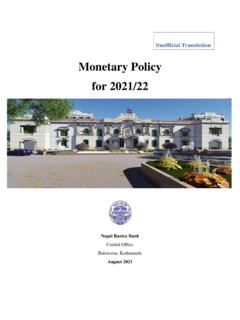




![PsLs[t lgb]{zg, @)&*](/cache/preview/c/9/4/8/1/7/3/6/thumb-c9481736ff2a35d3e2563fbfd6c09f64.jpg)

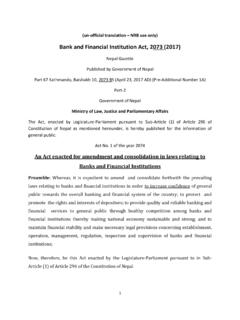
![cfly{s jif{ @)&*÷&( sf] df}lb|s gLltsf] klxnf] q}dfl;s ;dLIff](/cache/preview/1/1/1/9/d/2/5/5/thumb-1119d255f839d189d645cf52a0f2f356.jpg)

